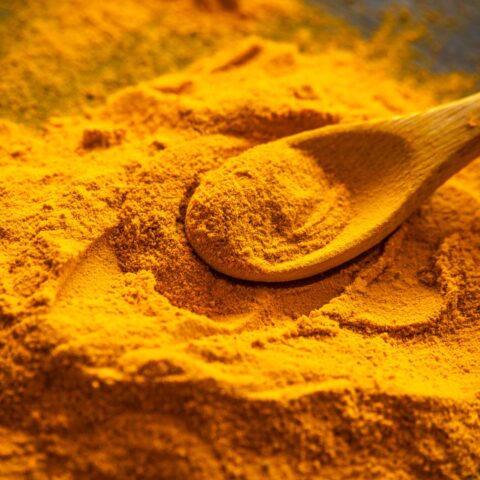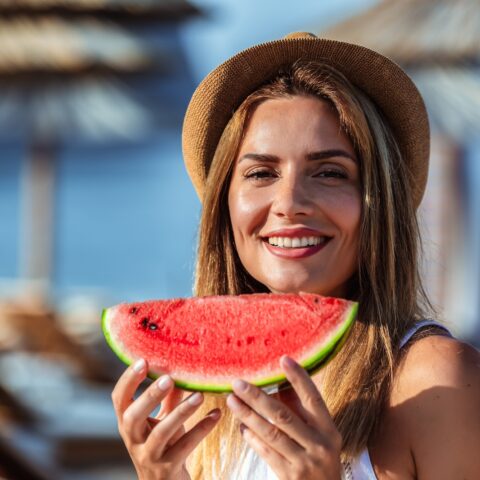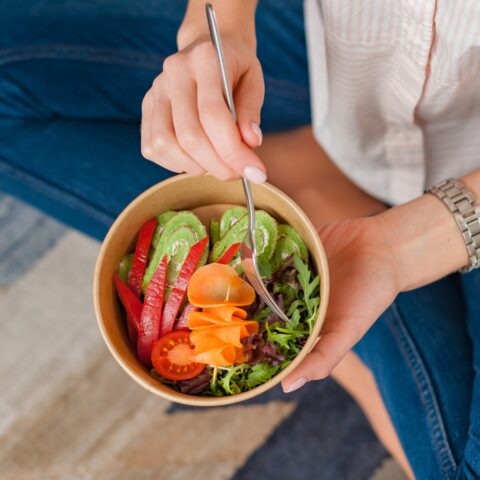How Healthy Are Pomegranates?
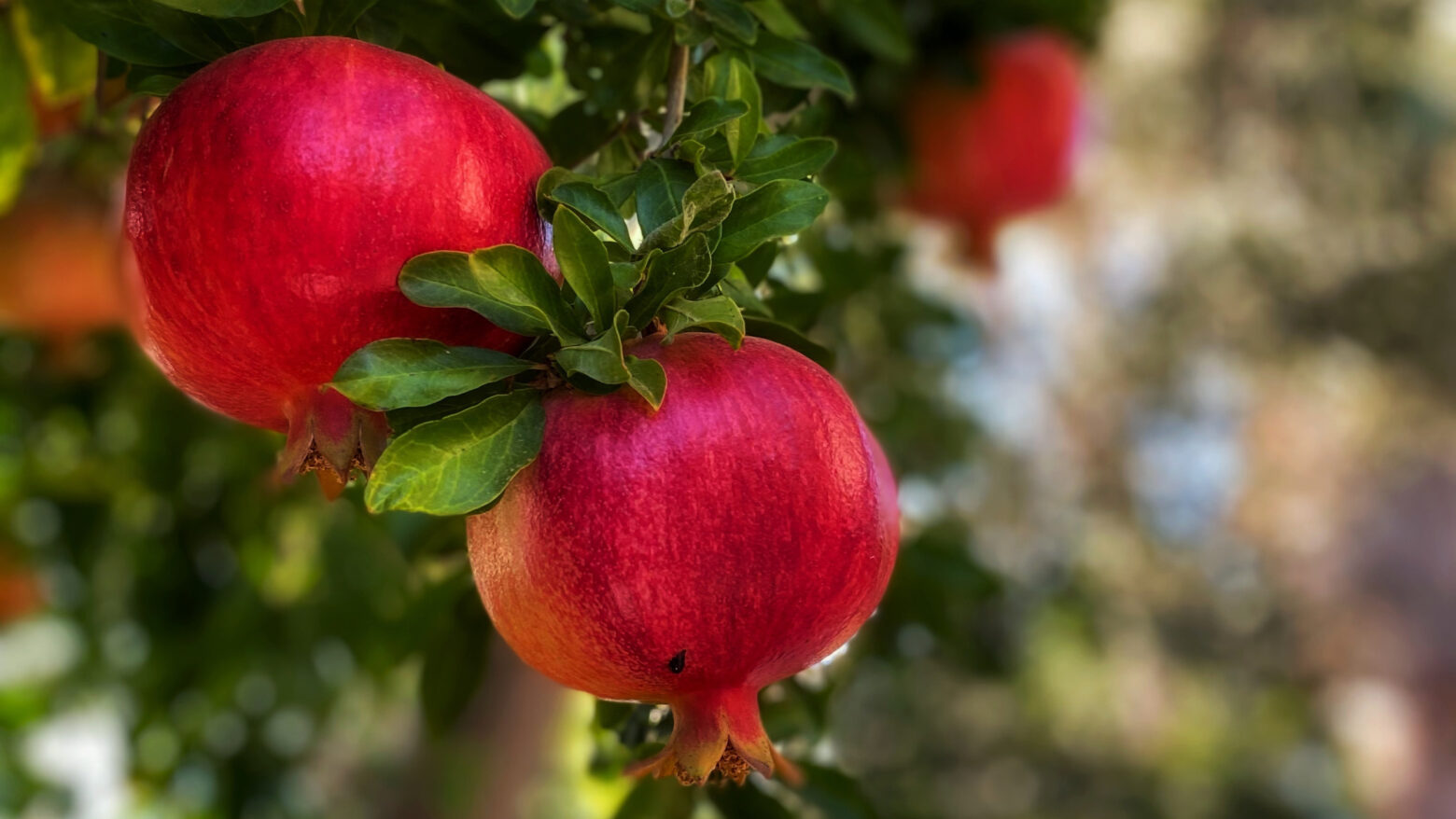
For many Paleo Dieters throughout the U.S., autumn represents the closure of fresh farmer’s markets and the end of the delicious local fruits and vegetables they produce. Nevertheless, late fall and October also signifies the beginning of pomegranate season, which in California (the major U.S. producer) runs from October through January.1
I am eagerly looking forward to munching down on this succulent and health-giving fruit. In fact, pomegranates are so healthful that they have been described as “Nature’s Power Fruit” by a writer from the Journal of the National Cancer Institute almost 13 years ago.2 In the ensuing decade, the scientific evidence leaves little doubt that this fruit, and its juice should be regular components of contemporary Paleo Diets.2-16
Pomegranate History
Pomegranates (Punica granatum) are one of the oldest known edible fruits and are thought to have originated in central Asia, predominantly in Iran.14,17 After domestication the pomegranate tree/shrub and its fruit eventually spread to other parts of the world where it could grow and thrive, chiefly in mild, temperate climates.14, 17 Wild pomegranate trees/shrubs still exist in present day Turkey.18 In the U.S. domesticated varieties are grown mainly in California and Arizona19 and form the greater part of current U.S. pomegranate consumption.
Edible Parts of the Pomegranate
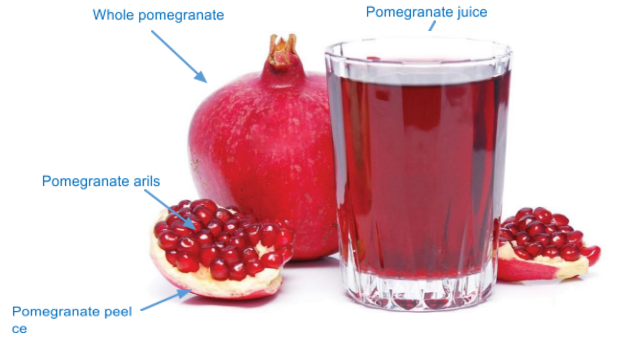
In the U.S., pomegranates and pomegranate juice have increasingly achieved a wider public acceptance because of their well-known health benefits.2-16 The primary, edible portion of pomegranate fruit is called the aril, which consists of the plant’s seed and the surrounding fruit (Figures 1, 2).14 The outer rind of the entire pomegranate fruit is called the peel, and the interior network of peel membranes is frequently called the mesocarp.15, 20-22 Most consumers consider the peel and mesocarp inedible.
Although many present-day cultivars of pomegranates maintain pink and red peel colors, wild varieties from Turkey may have peel colors ranging from yellow to purple, and arils with colors ranging from white to red.18 Dried arils called anardanas in India are commonly consumed both in India and Middle Eastern countries.14
Pomegranate juice can be extracted from the entire fruit (peel, aril fruit, aril seed and mesocarp) or a combination of these four elements,14,20,22 but it is most commonly made only from the fruit exterior of the arils, with the inner fibrous seed strained out.14 The remaining structures (peel, mesocarp and seed) are filtered from the juice and are called pomegranate marc.23
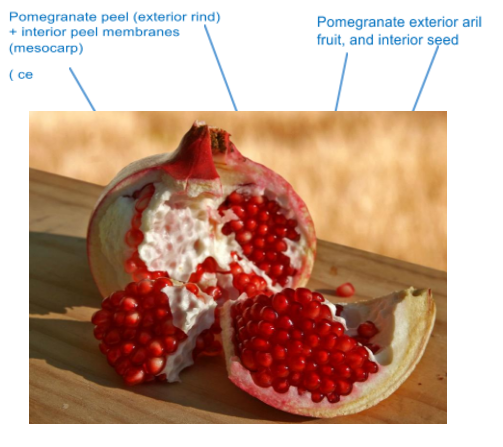
Pomegranate Nutrition
Table 1 below contrasts the nutritional characteristics of fresh pomegranate arils (fleshy fruit exterior + interior seeds) and pomegranate juice extracted from the arils without the seeds.
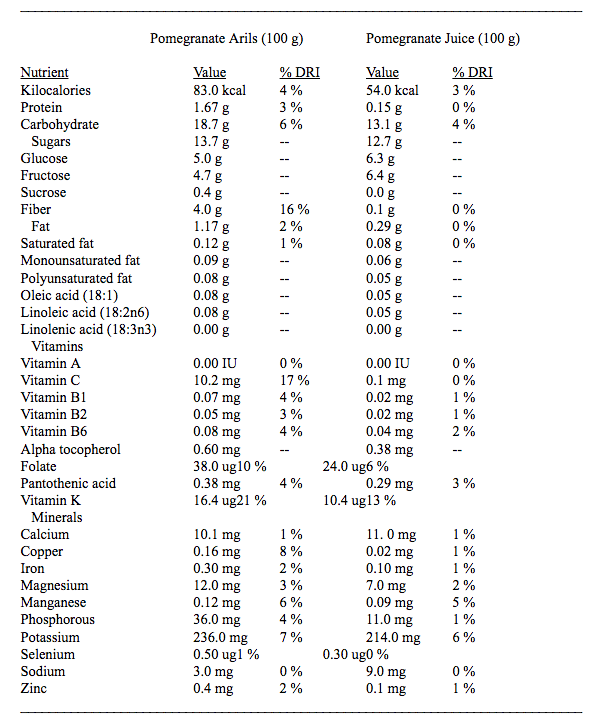
This Table may appear to be a bit cumbersome at first, but a few critical nutritional points should immediately jump out. First, fresh pomegranate arils are great sources of fiber, as a 100-gram portion of this food (only 83 kcal) provides a whopping 16% of recommended daily values for fiber. Additionally, a miniscule 83 kcal serving of fresh pomegranate fruit yields 17% of daily vitamin C requirements, 10% of daily folate requirements, 21% of the suggested vitamin K intake and 8% of recommended daily copper intakes.
No matter how you slice it nutritionally, fresh pomegranate arils are superb sources of many vitamins and minerals important to our health.
At first glance from Table 1, it may appear that pomegranate juice is less nutritionally dense (in terms of vitamins and minerals) than its arils’ counterpart. This fact is to be expected because pomegranate juice doesn’t contain all the compounds found in its seed. Nevertheless, both the arils (fleshy fruit exterior + interior seeds) and the juice made from the arils’ fleshy fruit exterior are rich sources of the phytochemicals25 which are primarily responsible for pomegranate’s multitude of health promoting effects.2-16
Pomegranate Phytochemicals
Whether you eat fresh pomegranate arils or drink its juice, you will be enhancing your diet with one of nature’s richest sources of disease preventing phytochemicals.25 “Phyto” means “Plant” chemicals which can either prevent or promote disease or have no effect. The entire pomegranate fruit contains at least 153 phytochemicals including their derivatives.14 In the case of pomegranate arils or pomegranate juice, numerous scientific studies show that these foods maintain powerful health promoting effects2-16 with no known toxic properties in their native form.20,26
Pomegranate Polyphenols
Polyphenols represent the predominant class of phytochemicals found in whole pomegranate fruit and are located in the pomegranate peel, mesocarp, arils and juice.22 The pomegranate peel and mesocarp contain much higher concentrations of polyphenols than what’s found in either the arils or juice.22 Generally, since most people consider the peel and mesocarp inedible, the intake of pomegranate polyphenols stems primarily from consumption of whole arils and juice.
Note that pomegranate supplements exist that are made from the dried peel and mesocarp of pomegranates. These supplements maintain much higher concentrations of total polyphenolics than values in fresh arils or juice. For instance, POM wonderful juice may contain a total polyphenolic content of 2,670 mg/liter whereas POMx capsules may exhibit a total polyphenolic concentration of 623,000 mg/kg.26
Obviously, nobody in their right mind would ever consume a kilogram (2.2 lbs.) of pomegranate capsules, but a 1-gram dose (623 mg total polyphenolics) or a 10-gram dose (6230 mg total polyphenolics) are possible with supplements. Personally, I enjoy fresh pomegranate arils or juice, and can achieve a high level of polyphenols without supplements.
Many of the therapeutic effects from pomegranate fruit or juice consumption are attributed to the powerful antioxidant, anti-inflammatory and anti-proliferative effects of pomegranate’s polyphenols.5,10,15,20-23,25-27 Pomegranate peel, mesocarp, arils and juice contain at least 48 individual polyphenols which can be subdivided into four major groups:
- Anthocyanins
- Hydrolysable tannins [including gallotannins and ellagitannins]
- Hydroxybenzoic acids
- Hydroxycinnamic acids.22
For reasons of expense, not all polyphenols are routinely measured.26 However, some of the major polyphenolic compounds commonly evaluated in pomegranates include:
- Gallic acids,
- Ellagic acids,
- Punicalagin A
- Punicalagin B.23
The last two polyphenols in this list are found in high concentrations in pomegranates15 and have been reported to maintain “remarkable” anti-inflammatory properties.23
An important factor when evaluating potential health benefits of pomegranate fruit and juice consumption is their total polyphenolic concentrations. Compared to other beverages, commercial pomegranate juices have demonstrated antioxidant activity three times higher than red wine and green tea.28 Using a more sophisticated battery of four antioxidant tests (TEAC, ORAC, DPPH and FRAP), Seeram and colleagues27 verified that pomegranate juice had the greatest antioxidant potency of 10 beverages tested and was at least 20% greater than any other beverage. The order of greatest antioxidant potency for this study was:
- Pomegranate juice
- Red wine
- Concord grape juice
- Blueberry juice
- Black cherry juice
- Acai juice
- Cranberry juice
- Orange juice
- Tea beverages (iced green, black, and white teas)
- Apple juice
Diet and Disease
One of the challenges faced by nutritional scientists, when they ultimately make recommendations regarding what we should and should not eat, is to establish cause and effect between a dietary element and the subsequent development or prevention of disease. Figure 3 below demonstrates the four primary procedures by which causality is established between diet and disease.29,30
No single procedure alone can establish cause and effect,29,30 nor can any single study prove causality.31 Observational epidemiological studies can only show relationships among variables and cannot provide decisive evidence by themselves either for or against specific hypotheses.32 In order to establish cause and effect between diet and disease, it takes more than just observational epidemiological evidence.32 There must also be biological plausibility in which evidence gathered from tissue, animal and short term human metabolic studies support causality.30 When observational epidemiological evidence is augmented by biological plausibility studies and confirmed by randomized controlled trials (RCT), the case for causality becomes ever more convincing.
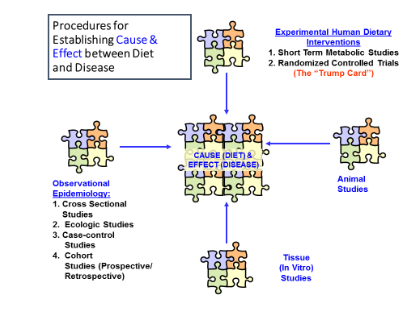
Pomegranates and Disease Prevention
In the case of pomegranates, a wealth of information exists from tissue and animal studies demonstrating therapeutic effects for all parts of the pomegranate fruit (peel, mesocarp, arils, juice) in treating and preventing a wide variety of disease models.
Numerous epidemiological studies have shown a multitude of beneficial health effects for fresh fruit and vegetable consumption,33-37 however little epidemiological evidence is specifically available for pomegranate consumption only. Despite the abundance of animal and tissue (pre-clinical) studies, considerably fewer randomized controlled trials in humans have been conducted for pomegranate consumption in a variety of diseases.
In some cases, the results of human RCT have been in conflict with tissue and animal trials for a variety of reasons including experimental design flaws.5, 26, 38-41 Nevertheless, taken in their entirety the evidence from animal, tissue and human RCT strongly supports pomegranate fruit, juice and extract consumption to be therapeutic for numerous illnesses and maladies.2-16, 20, 21, 26, 42-48
Advanced Glycation End Products (AGE) and Pomegranates
From my previous post on the topic of advanced glycation end products (AGE), you know that AGEs are compounds that naturally form in our bodies from the chemical reaction of sugars with proteins. In the past decade scientists have discovered that foods also contain AGEs that may greatly add to the AGE burden in our bodies.51 If the concentration of AGEs becomes excessive in our bloodstream, they can cause damage to almost every tissue and organ.49-51 The problem with AGEs is that they act like a key that permanently turns on low level inflammation49-51 in our bodies by binding to AGE receptors known as RAGEs.49, 52
It is now becoming clear to scientists that high tissue levels of AGEs are associated with almost all chronic diseases that afflict us in the western world.53-60 Additionally, excessive AGEs are known to speed the aging process.61, 62
This is where pomegranate fruit (arils, juice, mesocarp, peel) enter the picture. Their high polyphenolic concentrations may act as antioxidants that help to quell the underlying inflammatory process in many diseases.4, 5, 8, 9, 20, 21, 27, 28, 43-46, 48 A number of tissue (in vitro) studies63-65 have shown that pomegranate polyphenolics represent potent inhibitors of AGE formation. In mice fed a high sugar, high fat diet, pomegranate juice extract reduced the concentration of blood AGEs compared to a control group.3 As with other promising pre-clinical trials (tissue and animal) of pomegranate juice, at least one double-blind, 12-week RCT of pomegranate juice in adults with type 2 diabetes showed no effect upon blood AGEs, but did show an improvement in blood total antioxidant capacity along with a decrease in lipid peroxidation.66
Potential Therapeutic Influence of Pomegranates Upon Other Diseases
Pomegranate fruit (arils, juice, mesocarp, peel and extracts) clearly is not a universal panacea to cure all the diseases and illnesses that afflict humanity, but it does represent a powerful antioxidant and anti-inflammatory agent with the capacity to reduce inflammation throughout the body. Inflammation drives the major diseases of civilization including the metabolic syndrome, cancer and autoimmune diseases.
In this regard pomegranate may improve bone health in animal models4 and have therapeutic effects for humans in cancer prevention and therapy.5 It may also aid in the prevention and treatment of cardiovascular disease.6 Pomegranate juice consumption may have a therapeutic function in type 2 diabetics by lowering two markers (IL-6 and CRP) of inflammation.7 Similarly, in an RCT of 48 obese and overweight patients over 30 days, a 1000 mg pomegranate extract resulted in significant decreases of blood glucose, insulin, total cholesterol, LDL cholesterol, IL-6, CRP and lipid peroxidation.8 In an RCT (placebo controlled crossover) 28 subjects consuming 500 ml of pomegranate juice experienced significant reductions of both systolic and diastolic blood pressure, fasting insulin and improved insulin resistance.10
Finally, pomegranate fruit extracts may have therapeutic value for males with sub-fertility due to low sperm counts. An RCT of 66 men with low sperm counts ingested a pomegranate extract daily for three months or a placebo. After the treatment, the men taking the pomegranate extract experienced a 62% increase in the total number of motile sperm compared to the control group.13
References
[1] //www.amazing-pomegranate-health-benefits.com/fruit-season.html
[2] Longtin R. The pomegranate: nature’s power fruit? J Natl Cancer Inst. 2003 Mar 5;95(5):346-8.
[3] Kumagai Y, Nakatani S, Onodera H, Nagatomo A, Nishida N, Matsuura Y, Kobata K, Wada M. Anti-Glycation Effects of Pomegranate (Punica granatum L.) Fruit Extract and Its Components in Vivo and in Vitro. J
Agric Food Chem. 2015 Sep 9;63(35):7760-4.
[4] Spilmont M, Léotoing L, Davicco MJ, Lebecque P, Mercier S, Miot-Noirault E, Pilet P, Rios L, Wittrant Y, Coxam V. Pomegranate and its derivatives can improve bone health through decreased inflammation and oxidative stress in an animal model of postmenopausal osteoporosis. Eur J Nutr. 2014 Aug;53(5):1155-64.
[5] Turrini E, Ferruzzi L, Fimognari C. Potential Effects of Pomegranate Polyphenols in Cancer Prevention and Therapy. Oxid Med Cell Longev. 2015;2015:938475. doi: 10.1155/2015/938475.
[6] Vlachojannis C, Erne P, Schoenenberger AW, Chrubasik-Hausmann S. A critical evaluation of the clinical evidence for pomegranate preparations in the prevention and treatment of cardiovascular diseases. Phytother Res. 2015 Apr;29(4):501-8
[7] Sohrab G, Nasrollahzadeh J, Zand H, Amiri Z, Tohidi M, Kimiagar M. Effects of pomegranate juice consumption on inflammatory markers in patients with type 2 diabetes: A randomized, placebo-controlled trial. J Res Med Sci. 2014 Mar;19(3):215-20.
[8] Hosseini B, Saedisomeolia A, Wood LG, Yaseri M, Tavasoli S. Effects of pomegranate extract supplementation on inflammation in overweight and obese individuals: A randomized controlled clinical trial. Complement Ther Clin Pract. 2016 Feb;22:44-50.
[9] Zhao F, Pang W, Zhang Z, Zhao J, Wang X, Liu Y, Wang X, Feng Z, Zhang Y, Sun W, Liu J. Pomegranate extract and exercise provide additive benefits on improvement of immune function by inhibiting inflammation and oxidative stress in high-fat-diet-induced obesity in rats. J Nutr Biochem. 2016 Jun;32:20-8.
[10] Tsang C, Smail NF, Almoosawi S, Davidson I, Al-Dujaili EA. Intake of polyphenol-rich pomegranate pure juice influences urinary glucocorticoids, blood pressure and homeostasis model assessment of insulin resistance in human volunteers. J Nutr Sci. 2012 Aug 31;1:e9. doi: 10.1017/jns.2012.10.
[11] Medjakovic S, Jungbauer A. Pomegranate: a fruit that ameliorates metabolic syndrome. Food Funct. 2013 Jan;4(1):19-39
[12] Al-Muammar MN, Khan F. Obesity: the preventive role of the pomegranate (Punica granatum). Nutrition. 2012 Jun;28(6):595-604
[13] Fedder MD, Jakobsen HB, Giversen I, Christensen LP, Parner ET, Fedder J. An extract of pomegranate fruit and galangal rhizome increases the numbers of motile sperm: a prospective, randomised, controlled, double-blinded trial. PLoS One. 2014 Oct 2;9(9):e108532. doi: 10.1371/journal.pone.0108532.
[14] da Silva, J. A. T., Rana, T. S., Narzary, D., Verma, N., Meshram, D. T., & Ranade, S. A. (2013). Pomegranate biology and biotechnology: a review. Scientia Horticulturae, 160, 85-107.
[15] Faria A, Calhau C. The bioactivity of pomegranate: impact on health and disease. Crit Rev Food Sci Nutr. 2011 Aug;51(7):626-34.
[16] Shaygannia E, Bahmani M, Zamanzad B, Rafieian-Kopaei M. A Review Study on Punica granatum L. J Evid Based Complementary Altern Med. 2016 Jul;21(3):221-7
[17] Chandra, R., Babu, D. K., Jadhav, V. T., & da Silva, J. T. (2010). Origin, history and domestication of pomegranate. In Pomegranate. Fruit Veg. Cereal Sci. Biotechnol. (Vol. 4, pp. 1-6).
[18] Ercisli, S., Gadze, J., Agar, G., Yildirim, N., & Hizarci, Y. (2011). Genetic relationships among wild pomegranate (Punica granatum) genotypes from Coruh Valley in Turkey. Genet Mol Res, 10(1), 459-464.
[19] https://www.crfg.org/pubs/ff/pomegranate.html
[20] Lansky EP, Newman RA. Punica granatum (pomegranate) and its potential for prevention and treatment of inflammation and cancer. J Ethnopharmacol. 2007 Jan 19;109(2):177-206
[21] Ismail T, Sestili P, Akhtar S. Pomegranate peel and fruit extracts: a review of potential anti-inflammatory and anti-infective effects. J Ethnopharmacol. 2012 Sep 28;143(2):397-405
[22] Fischer UA, Carle R, Kammerer DR. Identification and quantification of phenolic compounds from pomegranate (Punica granatum L.) peel, mesocarp, aril and differently produced juices by HPLC-DAD-
ESI/MS(n). Food Chem. 2011 Jul 15;127(2):807-21
[23] Qu W, Breksa AP, Pan Z, Ma H. Quantitative determination of major polyphenol constituents in pomegranate products. Food Chem. 2012; 132: 1585-1591.
[24] Nutritionist Pro, Dietary Analysis Software. //nutritionistpro.com/
[25] Sreekumar S, Sithul H, Muraleedharan P, Azeez JM, Sreeharshan S. Pomegranate fruit as a rich source of biologically active compounds. Biomed Res Int. 2014;2014:686921. doi: 10.1155/2014/686921.
[26] Vlachojannis C, Zimmermann BF, Chrubasik-Hausmann S. Efficacy and safety of pomegranate medicinal products for cancer. Evid Based Complement Alternat Med. 2015;2015:258598. doi: 10.1155/2015/258598
[27] Seeram NP, Aviram M, Zhang Y, Henning SM, Feng L, Dreher M, Heber D.
Comparison of antioxidant potency of commonly consumed polyphenol-rich beverages in the United States. J Agric Food Chem. 2008 Feb 27;56(4):1415-22.
[28] Gil MI, Tomás-Barberán FA, Hess-Pierce B, Holcroft DM, Kader AA. Antioxidant activity of pomegranate juice and its relationship with phenolic composition and processing. J Agric Food Chem. 2000 Oct;48(10):4581-9.
[29] Sempos CT, Liu K, Ernst ND. Food and nutrient exposures: what to consider when evaluating epidemiologic evidence. Am J Clin Nutr. 1999;69(6):1330S-1338S.
[30] Potischman N, Weed DL. Causal criteria in nutritional epidemiology.
Am J Clin Nutr. 1999;69(6):1309S-1314S.
[31] Freudenheim JL. Study design and hypothesis testing: issues in the evaluation of evidence from research in nutritional epidemiology. Am J Clin Nutr. 1999; 69(6): 1315S-1321S.
[32] Flegal KM. Evaluating epidemiologic evidence of the effects of food and nutrient exposures. Am J Clin Nutr. 1999;69:1339S-1344S.
[33] Wang X, Ouyang Y, Liu J, Zhu M, Zhao G, Bao W, Hu FB. Fruit and vegetable consumption and mortality from all causes, cardiovascular disease, and cancer: systematic review and dose-response meta-analysis of prospective cohort studies. BMJ. 2014 Jul 29;349:g4490. doi: 10.1136/bmj.g4490.
[34] Gan Y, Tong X, Li L, Cao S, Yin X, Gao C, Herath C, Li W, Jin Z, Chen Y, Lu Z.
Consumption of fruit and vegetable and risk of coronary heart disease: a meta-analysis of prospective cohort studies. Int J Cardiol. 2015 Mar 15;183:129-37.
[35] Hu D, Huang J, Wang Y, Zhang D, Qu Y. Fruits and vegetables consumption and risk of stroke: a meta-analysis of prospective cohort studies. Stroke. 2014 Jun;45(6):1613-9.
[36] Aune D, Chan DS, Vieira AR, Rosenblatt DA, Vieira R, Greenwood DC, Norat T. Fruits, vegetables and breast cancer risk: a systematic review and meta-analysis of prospective studies. Breast Cancer Res Treat. 2012 Jul;134(2):479-93.
[37] Vieira AR, Abar L, Vingeliene S, Chan DS, Aune D, Navarro-Rosenblatt D, Stevens C, Greenwood D, Norat T. Fruits, vegetables and lung cancer risk: a systematic review and meta-analysis. Ann Oncol. 2016 Jan;27(1):81-96.
[38] Núñez-Sánchez MA, González-Sarrías A, Romo-Vaquero M, García-Villalba R, Selma MV, Tomás-Barberán FA, García-Conesa MT, Espín JC. Dietary phenolics against colorectal cancer–From promising preclinical results to poor translation into clinical trials: Pitfalls and future needs. Mol Nutr Food Res. 2015 Jul;59(7):1274-91
[39] Sahebkar A, Gurban C, Serban A, Andrica F, Serban MC Effects of supplementation with pomegranate juice on plasma C-reactive protein concentrations: A systematic review and meta-analysis of randomized controlled trials. Phytomedicine. 2016 Oct 15;23(11):1095-102.
[40] Sahebkar A, Simental-Mendía LE, Giorgini P, Ferri C, Grassi D. Lipid profile changes after pomegranate consumption: A systematic review and meta-analysis of randomized controlled trials. Phytomedicine. 2016 Oct 15;23(11):1103-12
[41] González-Ortiz M, Martínez-Abundis E, Espinel-Bermúdez MC, Pérez-Rubio KG. Effect of pomegranate juice on insulin secretion and sensitivity in patients with obesity. Ann Nutr Metab. 2011;58(3):220-3.
[42] Asgary S, Keshvari M, Sahebkar A, Sarrafzadegan N. Pomegranate consumption and blood pressure: A review. Curr Pharm Des. 2016 Oct 10. [Epub ahead of print]
[43] Ghavipour M, Sotoudeh G, Tavakoli E, Mowla K, Hasanzadeh J, Mazloom Z.
Pomegranate extract alleviates disease activity and some blood biomarkers of inflammation and oxidative stress in Rheumatoid Arthritis patients. Eur J Clin Nutr. 2016 Aug 31. doi: 10.1038/ejcn.2016.151. [Epub ahead of print]
[44] Shishehbor F, Mohammad Shahi M, Zarei M, Saki A, Zakerkish M, Shirani F, Zare M.
Effects of Concentrated Pomegranate Juice on Subclinical Inflammation and Cardiometabolic Risk Factors for Type 2 Diabetes: A Quasi-Experimental Study. Int J Endocrinol Metab. 2016 Jan 30;14(1):e33835. doi: 10.5812/ijem.33835.
[45] Ghoochani N, Karandish M, Mowla K, Haghighizadeh MH, Jalali MT. The effect of pomegranate juice on clinical signs, matrix metalloproteinases and antioxidant status in patients with knee osteoarthritis. J Sci Food Agric. 2016 Oct;96(13):4377-81.
[46] Shema-Didi L, Sela S, Ore L, Shapiro G, Geron R, Moshe G, Kristal B. One year of pomegranate juice intake decreases oxidative stress, inflammation, and incidence of infections in hemodialysis patients: a randomized placebo-controlled trial. Free Radic Biol Med. 2012 Jul 15;53(2):297-304.
[47] Davidson MH, Maki KC, Dicklin MR, Feinstein SB, Witchger M, Bell M, McGuire DK, Provost JC, Liker H, Aviram M. Effects of consumption of pomegranate juice on carotid intima-media thickness in men and women at moderate risk for coronary heart disease. Am J Cardiol. 2009 Oct 1;104(7):936-42.
[48] Shema-Didi L, Kristal B, Ore L, Shapiro G, Geron R, Sela S. Pomegranate juice intake attenuates the increase in oxidative stress induced by intravenous iron during hemodialysis. Nutr Res. 2013 Jun;33(6):442-6.
[49] Alexiou P, Chatzopoulou M, Pegklidou K, Demopoulos VJ. RAGE: a multi-ligand receptor unveiling novel insights in health and disease. Curr Med Chem. 2010;17(21):2232-52.
[50] Barlovic DP, Thomas MC, Jandeleit-Dahm K. Cardiovascular disease: what’s all the AGE/RAGE about? Cardiovasc Hematol Disord Drug Targets. 2010 Mar;10(1):7-15.
[51] Bengmark S. Advanced glycation and lipoxidation end products–amplifiers of inflammation: the role of food. JPEN J Parenter Enteral Nutr. 2007 Sep-Oct;31(5):430-40.
[52] Yan SF, Ramasamy R, Schmidt AM. The RAGE axis: a fundamental mechanism signaling danger to the vulnerable vasculature. Circ Res. 2010 Mar 19;106(5):842-53.
to the vulnerable vasculature. Circ Res. 2010 Mar 19;106(5):842-53.
[53] Nowotny K, Jung T, Höhn A, Weber D, Grune T. Advanced glycation end products and oxidative stress in type 2 diabetes mellitus. Biomolecules. 2015 Mar 16;5(1):194-222.
[54] Baumann M. Role of advanced glycation end products in hypertension and cardiovascular risk: human studies. J Am Soc Hypertens. 2012 Nov-Dec;6(6):427-35.
[55] Mallipattu SK, Uribarri J. Advanced glycation end product accumulation: a new enemy to target in chronic kidney disease? Curr Opin Nephrol Hypertens. 2014 Nov;23(6):547-54.
[56] Rahmadi A, Steiner N, Münch G. Advanced glycation endproducts as gerontotoxins and biomarkers for carbonyl-based degenerative processes in Alzheimer’s disease. Clin Chem Lab Med. 2011 Mar;49(3):385-91.
[57] Rojas A, Pérez-Castro R, González I, Delgado F, Romero J, Rojas I. The emerging role of the receptor for advanced glycation end products on innate immunity. Int Rev Immunol. 2014 Jan;33(1):67-80.
[58] Foster D, Spruill L, Walter KR, Nogueira LM, Fedarovich H, Turner RY, Ahmed M, Salley JD, Ford ME, Findlay VJ, Turner DP. AGE metabolites: a biomarker linked to cancer disparity? Cancer Epidemiol Biomarkers Prev. 2014 Oct;23(10):2186-91.
[59] Nagaraj RH, Linetsky M, Stitt AW. The pathogenic role of Maillard reaction in the aging eye. Amino Acids. 2012 Apr;42(4):1205-20.
[60] Ciccocioppo R, Imbesi V, Betti E, Boccaccio V, Kruzliak P, Gallia A, Cangemi GC, Maffe GC, Vanoli A, Merante S, De Amici M, Falcone C, Klersy C, Corazza GR. The Circulating Level of Soluble Receptor for
Advanced Glycation End Products Displays Different Patterns in Ulcerative Colitis and Crohn’s Disease: A Cross-Sectional Study. Dig Dis Sci. 2015 Mar 11. [Epub ahead of print].
[61] Van Puyvelde K, Mets T, Njemini R, Beyer I, Bautmans I. Effect of advanced glycation end product intake on inflammation and aging: a systematic review. Nutr Rev. 2014 Oct;72(10):638-50.
[62] Semba RD, Nicklett EJ, Ferrucci L. Does accumulation of advanced glycation end products contribute to the aging phenotype? J Gerontol A Biol Sci Med Sci. 2010 Sep;65(9):963-75.
[63] Dorsey PG, Greenspan P. Inhibition of nonenzymatic protein glycation by pomegranate and other fruit juices. J Med Food. 2014 Apr;17(4):447-54.
[64] Ito H, Li P, Koreishi M, Nagatomo A, Nishida N, Yoshida T. Ellagitannin oligomers and a neolignan from pomegranate arils and their inhibitory effects on the formation of advanced glycation end products. Food Chem. 2014;152:323-30.
[65] Liu W, Ma H, Frost L, Yuan T, Dain JA, Seeram NP. Pomegranate phenolics inhibit formation of advanced glycation endproducts by scavenging reactive carbonyl species. Food Funct. 2014 Nov;5(11):2996-3004.
[66] Sohrab G, Angoorani P, Tohidi M, Tabibi H, Kimiagar M, Nasrollahzadeh J. Pomegranate (Punicagranatum) juice decreases lipid peroxidation, but has no effect on plasma advanced glycated end-products in adults with type 2 diabetes: a randomized double-blind clinical trial. Food Nutr Res. 2015 Sep 8;59:28551. doi: 10.3402/fnr.v59.28551
Loren Cordain, Ph.D.
As a professor at Colorado State University, Dr. Loren Cordain developed The Paleo Diet® through decades of research and collaboration with fellow scientists around the world.
More About The Author
